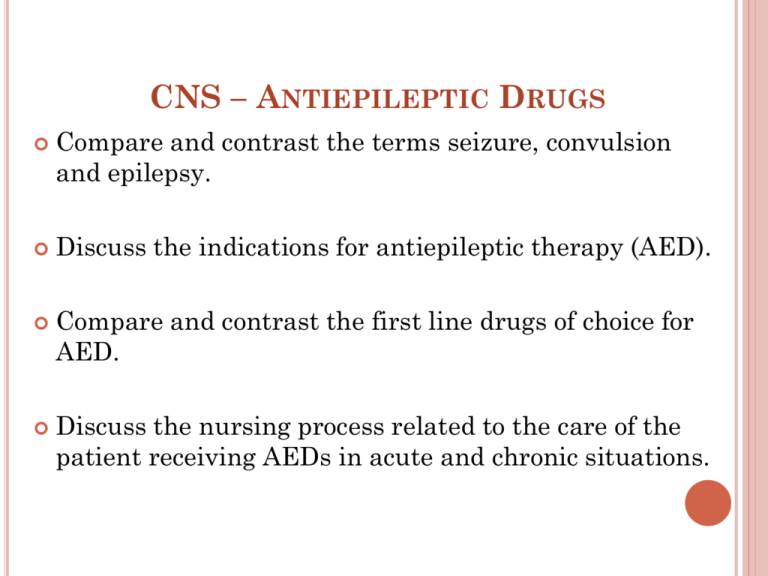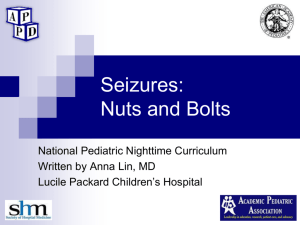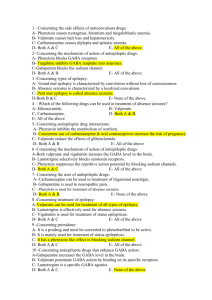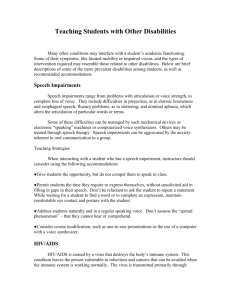cns – antiepileptic drugs
advertisement

CNS – ANTIEPILEPTIC DRUGS Compare and contrast the terms seizure, convulsion and epilepsy. Discuss the indications for antiepileptic therapy (AED). Compare and contrast the first line drugs of choice for AED. Discuss the nursing process related to the care of the patient receiving AEDs in acute and chronic situations. CNS – ANTIEPILEPTIC DRUGS INTERNATIONAL CLASSIFICATION OF SEIZURES Partial Seizures – short alterations of consciousness; repetitive unusual movements (chewing or swallowing); psychologic changes; confusion Simple Seizures – No impaired consciousness; motor symptoms of face, arm or legs; hallucinations of sight, hearing, or taste; tingling sensation; ANS changes; personality changes Complex Seizures – Impaired consciousness; memory impairment; behavioral effects; purposeless behaviors; aura, unreal feelings, bizarre behavior Generalized Seizures – Temporary lapses in consciousness; staring off into space; rhythmic movements of eyes, head, or hands; may have tonic, clonic, myoclonic, atonic, or tonic-clonic seizures; brief loss of consciousness without confusion; head drop or falling down symptoms CNS – ANTIEPILEPTIC DRUGS SYNDROME OF CNS DYSFUNCTION Convulsion – Involuntary spasmodic contractions of any or all voluntary muscles throughout the body, including skeletal and facial muscles. Postictal state Seizures – Brief episode of abnormal electrical activity in the nerve cells of the brain -- detected on EEG Epilepsy – Chronic, recurrent pattern of seizures CNS ANTIEPILEPTIC DRUGS /ANTICONVULSANT DRUGS Terms overlap and are used interchangeably to achieve the goal of maintaining a reasonable quality of life. Antiepileptic Drugs: management of all types of epilepsy, not just convulsions (AED Therapy) Anticonvulsant Drugs: used to prevent the seizures typically associated with epilepsy. CNS – ANTIEPILEPTIC DRUGS MECHANISM OF ACTION ION Theory – movement of K+, Na+, Ca+, Mg+: Stabilizes neurons: from becoming hyperexcited prevents excessive impulses to adjacent neurons 1. Increase threshold of activity in the motor cortex Makes it more difficult to excite; reduces response 2. Depress the seizure discharge from its origin Suppress transmission of impulses from one nerve to the next 3. Decrease the speed of nerve impulse conduction within a given neuron CNS – ANTIEPILEPTIC DRUGS INDICATIONS Prevention or control of seizure activity Long-term maintenance treatment of epilepsy Acute treatment of convulsions and status epilepticus Status epilepticus: common seizure disorder – life-threatening emergency characterized by tonic-clonic convulsions that occur in succession. Loss of consciousness, hypotension, hypoxia, cardiac dysrhythmias – brain damage and death may quickly result Once controlled, long term therapy is begun to prevent future seizures Brain Surgery - Head injuries = prophylactic AED Therapy CNS – ANTIEPILEPTIC DRUGS CONTRAINDICATIONS Known drug allergy Pregnancy – consider risks to mother & infant if untreated CNS – ANTIEPILEPTIC DRUGS DRUGS OF FIRST CHOICE AED Therapy Therapeut ic Level (mcg/mL) Adverse Effects carbamazepine (Tegretol) 3-14 N/V; drowsiness; dizziness; orthostatic hypotension; hypertension; dyspnea; edema; nephrotoxicity; hepatotoxicity; blood dyscrasias; dermatologic reactions phenytoin (Dilantin) 10-20 Cardiac dysrhythmias; hypotension; N/V indigestion; sedation, drowsiness, dizziness, blurred vision, fatigue, lethargy; confusion; gingival hyperplasia; hyperglycemia; blood dyscrasias; hepatoxicity; dermatologic reactions primidone (Mysoline) 5-12 Sedation; drowsiness; dizziness; blurred vision; blood dyscrasias; paradoxical excitability valproic acid (Depakote) Drowsiness; N/V; tremor; weight gain; transient hair loss; blood dyscrasias; hepatotoxicity; pancreatitis 50-100 CNS – ANTIEPILEPTIC DRUGS Treatment of Status Epilepticus AED Therapy Dose Onset mg/kg Adverse Effects diazepam (Valium) 0.3-0.5 3-10 mins Apnea, hypotension, somnolence Fosphenytoin (Cerebyx) 15-20 15-30 mins Cardiac dysrhythmias, hypotension Lorazepam (Ativan) 0.050.1 1-20 mins Phenobarbital 15-20 10-30 mins Apnea, hypotension, somnolence Phenytoin (Dilantin) 15-20 5-30 mins Apnea, hypotension, somnolence Cardiac dysrhythmias, hypotension CNS – ANTIEPILEPTIC DRUGS BENZODIAZEPINES Actions Not fully understood May enhance the inhibitory effects of GABA in postsynaptic clefts between nerve cells Uses Diazepam (Valium), clonazepam (Klonopin), clorazepate (Tranxene), lorazepam (Ativan) Diazepam - drug of choice for status epilepticus must be given intravenously -- slowly never mixed with any other medication Therapeutic outcomes Reduced frequency of seizures, reduced injuries Minimal adverse effects from therapy CNS – ANTIEPILEPTIC DRUGS HYDANTOINS Actions – mechanism unknown phenytoin (Dilantin) – most commonly used ethotoin (Peganone) fosphenytoin (Cerebyx) Uses Anticonvulsants used to control tonic-clonic seizures CAUTION: Phenytoin must be administered slowly Do not mix with other medications in the same syringe Dilute only with 0.9% NaCl to avoid precipitation Infuse slowly <150mg/min CAUTION: toxicity may cause nystagmus CAUTION: infiltration causes sloughing of tissue Therapeutic outcomes Reduced frequency of seizures, reduced injuries Minimal adverse effects from therapy CNS – ANTIEPILEPTIC DRUGS CARBAMAZEPINE Actions -- carbamazepine (Tegretol) Blocks up the reuptake of norepinephrine Decreases release of norepinephrine and rate of dopamine and GABA turnover Mechanisms of action as anticonvulsant are unknown Uses Used in combination with other anticonvulsants to control tonic-clonic seizures Not effective for myoclonic or absence seizures Should not be given with grapefruit – increased levels of the AED Therapeutic outcomes Reduced frequency of seizures, reduced injuries Minimal adverse effects from therapy CNS – ANTIEPILEPTIC DRUGS SUCCINIMIDES Actions ethosuximide (Zarontin), methsuximide (Celontin) Uses Mechanism of action unknown To control absence (petit mal) seizures Therapeutic outcomes Reduced frequency of seizures, reduced injuries Minimal adverse effects from therapy CNS – ANTIEPILEPTIC DRUGS TOPIRAMATE Actions topiramate (Topomax) Mechanisms of action are unknown May prolong blockade of sodium channels, enhance activity of GABA, and antagonize certain neurotransmitter receptors Uses Used in combination with other anticonvulsants to control tonic-clonic seizures Prevention of migraine headaches Therapeutic outcomes Reduced frequency of seizures and injuries Minimal adverse effects from therapy CNS – ANTIEPILEPTIC DRUGS PRIMIDONE Actions primidone (Mysoline) Metabolized into phenobarbital and PEMA - both active anticonvulsants Exact anticonvulsant mechanism of action is unknown Uses Used in combination with other anticonvulsants to treat tonic-clonic seizures Therapeutic outcomes Reduced frequency of seizures and injuries Minimal adverse effects from therapy CNS – ANTIEPILEPTIC DRUGS GABAPENTIN Actions gabapentin (Neurontin) Mechanisms of action are unknown Does not appear to enhance GABA Uses Used in combination with other anticonvulsants to control partial seizures Therapeutic outcomes Reduced frequency of seizures Minimal adverse effects from therapy Also used for pain reduction – shingles, peripheral neuropathy – nerve pain CNS – ANTIEPILEPTIC DRUGS NURSING IMPLICATIONS Nurses may play an important role in diagnosis and treatment Comprehensive history – allergies/medication reconciliation Describe seizures – precipitating events, duration/frequency, intensity of the seizure activity, postictal behavior – observe & record Safety – positioning – assist pt during seizure, proper supplies Medication administration guidelines – specific for IV meds Lab values – check therapeutic blood levels on admission Patient and family support: discuss lifestyle and feelings with patient CNS – ANTIEPILEPTIC DRUGS PATIENT EDUCATION Medication: adherence to prescribe regimen Do not Stop Abruptly – Life Time Treatment - Rebound Convulsions Medic Alert Bracelet Protective environment Driving – physician prescription/State laws Sedating effects of the drugs – may decrease with time Avoid alcohol & cigarettes Photosensitivity with certain AEDs – sunscreen & protective clothing Avoid stimulants Oral hygiene – hyperplasia CNS – ANTIEPILEPTIC DRUGS REVIEW When caring for a patient with epilepsy who was hospitalized and successfully treated for status epilepticus, a precaution that the nurse institutes includes: a. placing oxygen and suction equipment at the bedside. b. assigning an assistant to stay with the patient at all times. c. keeping an airway available to insert as needed. d. instructing the patient to stay in bed and call for assistance to go to the bathroom. CNS – ANTIEPILEPTIC DRUGS REVIEW A nurse witnesses a patient with a seizure disorder as he suddenly jerks his arms and legs with tonic-clonic type movement, falls to the floor, temporary loss of consciousness, which he regains immediately. The type of seizure demonstrated by this patient and that the nurse documents is: a. atonic seizure b. myoclonic seizure c. complex partial seizure with automatisms d. generalized seizure






